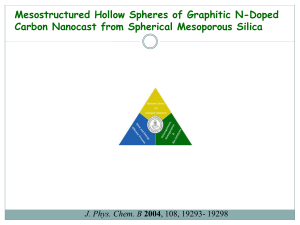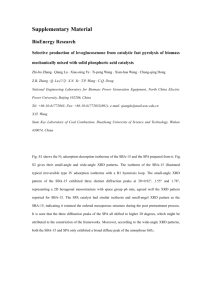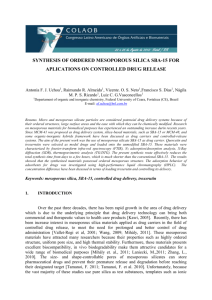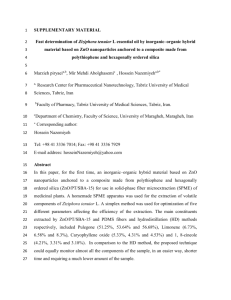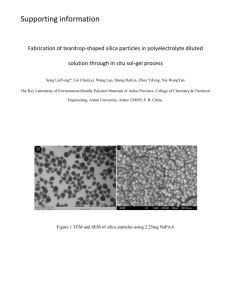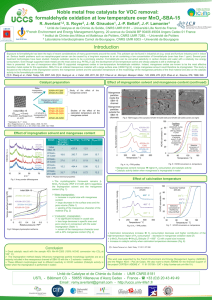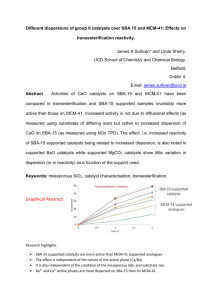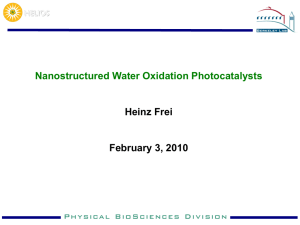S1. Synthesis of porous silica particles
advertisement
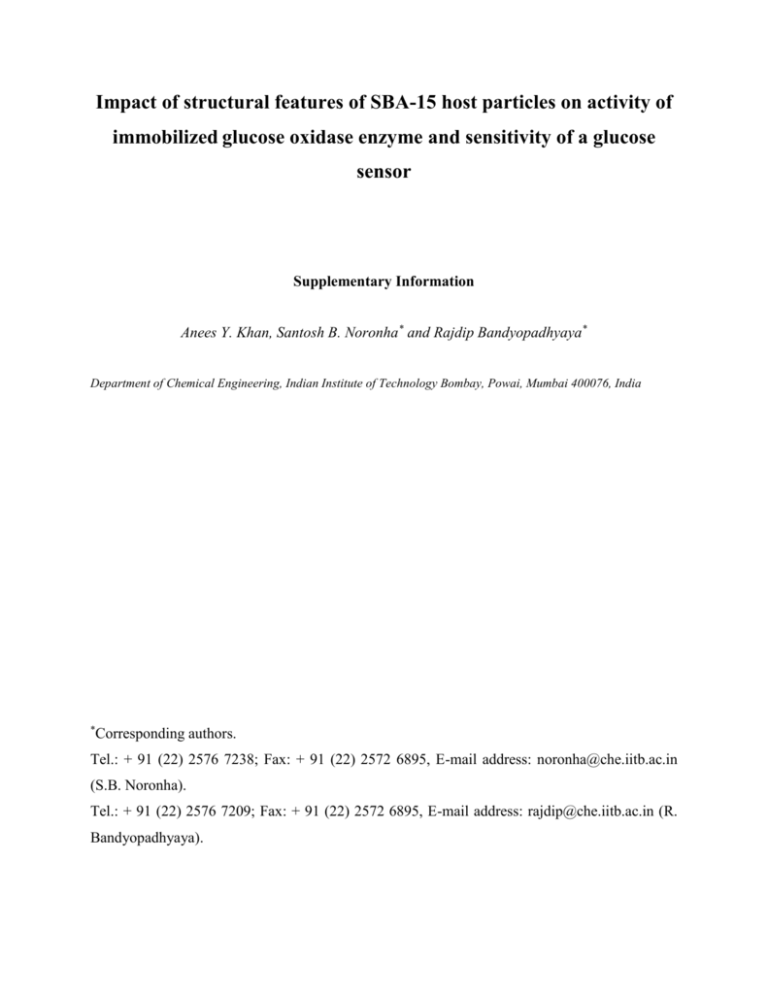
Impact of structural features of SBA-15 host particles on activity of immobilized glucose oxidase enzyme and sensitivity of a glucose sensor Supplementary Information Anees Y. Khan, Santosh B. Noronha* and Rajdip Bandyopadhyaya* Department of Chemical Engineering, Indian Institute of Technology Bombay, Powai, Mumbai 400076, India * Corresponding authors. Tel.: + 91 (22) 2576 7238; Fax: + 91 (22) 2572 6895, E-mail address: noronha@che.iitb.ac.in (S.B. Noronha). Tel.: + 91 (22) 2576 7209; Fax: + 91 (22) 2572 6895, E-mail address: rajdip@che.iitb.ac.in (R. Bandyopadhyaya). S1. Synthesis of porous silica particles S1.1 Microporous silica (MS) Synthesis protocol of MS was based on Onida et al. [1] and given as follows: TEOS is added to aqueous solution of NaOH and reacted for 3 h at room temperature under constant magnetic stirring. The molar ratios of the reactants are given below: TEOS : NaOH : H2O = 1.00 : 0.40 : 525 Fig. S1. SEM images of MS particles (mean particle diameter 200 nm with standard deviation 25 nm). Fig. S1 is an SEM image of MS particles. Its shows isolated particles with spherical morphology. As MS particles prepared by above method cannot be analyzed in CLSM, due to small particle diameter of 200 nm (Fig. S1), bigger MS were synthesized (mean diameter 35 μm, with standard deviation 5 μm, Fig. 2a). Synthesis protocol was based on [2] and given as follows: Acetic acid (AA, 11.4 ml) was added to 3.4 ml water under magnetic stirring followed by addition of 10 ml of TEOS. The reaction was continued for 3 h at room temperature. The molar ratio of reactants was as follows: AA: H2O: TEOS = 1: 4: 4. S1.2 Fibre-like SBA-15 Pluronic P123 (2 g) was dissolved in distilled water (65 ml) giving a concentration of 5.3 mM. Concentrated HCl (10 ml, 35%) was added and stirred for 4 h followed by drop-wise addition of TEOS (4.5 ml) and stirred for 24 h at 35o C. The mixture was kept in a closed vessel at 100o C for another 48 h under static condition. The molar ratio of reactants was as follows: P123: HCl: H2O: TEOS = 1: 235: 11360: 60. S1.3 Rod-like SBA-15 2.4 g Pluronic 123 was dissolved in 84 ml HCl solution (1.07 M) at 40o C giving a P123 concentration of 4.93 mM. Then 0.027 g NH4F was added followed by drop-wise addition of 5.466 ml TEOS under stirring (300-400 rpm) and reacted at 40o C for 20 h. The mixture was kept in a closed vessel under static conditions for further reaction at 100o C for 48 h. The molar ratio of reactants used was as follows: P123: HCl: NH4F: H2O: TEOS = 1: 217: 1.8: 11030: 60. S1.4 Cuboid SBA-15 1.5 g Pluronic 123 was dissolved in 55 ml of 1.3 M HCl solution at 30o C, giving a P123 concentration of 4.7 mM. Then 0.027 g NH4F was added followed by 11.762 ml decane and stirred for 5 h. Finally, TEOS (3.464 ml) was added drop wise for 2 minutes. The mixture was stirred at 30o C for 20 h and then kept in a closed vessel under static conditions for further reaction at 100o C for 48 h. The molar ratio of reactants used was as follows: P123: HCl: NH4F: C10H22 : H2O: TEOS = 1: 261:1.8: 135: 11278: 60. In all cases, the solid product was filtered, washed, dried at ambient condition and calcined at 540o C for 6 h. S1.5 Morphological changes in SBA-15 A possible reason for these morphological changes in SBA-15 is as follows: on addition of the silica precursor, TEOS, in an acidic medium, it undergoes hydrolysis and condensation reactions resulting in polymeric silicate species. Then, self assembly between polymeric silicate species and P123 micelles take place, which results in silicatropic liquid crystal seeds. These seeds grow continuously via side-by-side anchoring along the long axis, and gives different particle morphologies. Slower hydrolysis rate in the case of fibre (due to the absence of NH4F being used as a hydrolysis-catalyst) may result in slower reaction and nucleation rate, hence smaller number of initial seed particles, which continue to grow and yield larger fibre-shaped particles at the end of the process. NH4F was used as a hydrolysis-catalyst with mole ratio (NH4F/P123) from 0 (in case of fibre) to 1.8 (in case of both rod and cuboid), which promotes polymerization of TEOS. The latter condition may result in faster reaction and nucleation rates, and hence larger number of seeds leading eventually to smaller rod- or cuboid-shaped particles. In addition, in case of cuboid SBA-15 synthesis, decane serves as a pore expander, and also confines the silica doped micelles, resulting in a decreased particle size [3]. S2. GOD Assay A known mass of GOD immobilized SBA-15 was reacted with 100 mM glucose in 0.2 M phosphate buffer (pH 7), for 10 min. at 26o C. Next, the supernatant was obtained on centrifugation at 13000 rpm for 5 min. A known aliquot of the supernatant was mixed with an assay mixture (containing 10 units of HRP, 0.2 mM AAP, and 2.5 mM phenol). The concentration of the resultant pink quinoneimine complex, as determined spectrophotometrically (at 510 nm) was obtained by multiplying the absorbance with the dilution factor and a calibration plot. This gives activity of the immobilized GOD. The step involving separate addition of the supernatant (which contains enzymatically generated hydrogen peroxide product) to the assay mixture was required. There could otherwise be an underestimation of the true activity due to adsorption of pink quinoneimine complex on silica particles. Free GOD activity (in absence of silica) was measured under the same condition, as that of immobilization conditions, for proper comparison. All experiments were carried out under sterile conditions. S3. Labeling of GOD with rhodamine red dye A standard labeling procedure of rhodamine red dye on GOD was followed [4]. 10 mg of GOD was dissolved in 1 ml of 0.1 M sodium bicarbonate buffer (pH 9). Separately, a dye solution was prepared by dissolving 10 mg rhodamine red dye in 1 ml dimethyl sulfoxide. This dye solution was then added slowly to the GOD solution and the reaction was continued for 4 h under dark condition with constant stirring. Finally, the mixture was eluted through a PD-10 desalting column to separate out the rhodamine red labeled GOD with the unconjugated dye. The concentration of dye labeled GOD was calculated to be 4.3 mg/ml with 1 degree of labeling. Dye labeled GOD was then immobilized onto MS and fibre-like SBA-15 by a procedure as mentioned in section 2.3. S4. Materials characterization S4.1 SAXS data (100) SBA-15 morphology Fibre Rod Cuboid (110) (200) Intensity (a.u.) (110) (200) 1.0 1.2 1.4 1.6 q (nm-1) 0.6 0.9 1.2 1.5 1.8 2.1 q(nm-1) Figure S2. Small angle X-ray scattering (SAXS) of SBA-15 with fibre, rod and cuboid morphologies. Based on position of the first peak, interpore distances for these morphologies are 10.6, 12.8 and 14.4 nm respectively. Inset shows SAXS for fibre and rod SBA-15. For complementary confirmation of arrangement of mesopores, small angle X-ray scattering (SAXS) data in Fig. S2 shows that SBA-15 with fibre and cuboid morphology have three peaks which can be indexed closely to (1 0 0), (1 1 0) and (2 0 0) planes, respectively [peaks corresponding to (1 1 0) and (2 0 0) planes for fibre-like SBA-15 is shown in inset]. The rod form of SBA-15 has two peaks corresponding to (1 0 0) and (1 1 0) planes, respectively. This confirms hexagonal arrangement of pores in all morphologies. Based on reflection of (1 0 0) plane, the calculated interpore distances (for a hexagonal geometry) for fibre, rod and cuboid SBA-15 are 10.6, 12.8 and 14.4 nm respectively. S4.2 Nitrogen sorption data before and after GOD immobilization (a) 600 Fibrelike SBA-15 Without GOD With GOD 0.25 3 Pore volume (cm /g) 3 Quantity adsorbed (cm /g) 500 (b) 0.30 Fibrelike SBA-15 without GOD with GOD 400 300 200 0.20 0.15 0.10 0.05 100 0.00 0 0.0 0.2 0.4 900 0.8 0 1.0 2 4 6 8 0.12 Rodlike SBA-15 Without GOD With GOD 700 10 12 14 16 18 20 22 24 Pore diameter (nm) (c) 800 (d) Rodlike SBA-15 without GOD with GOD 0.10 0.08 600 3 Pore volume (cm /g) 3 Quantity adsorbed (cm /g) 0.6 P/Po 500 400 300 200 0.06 0.04 0.02 100 0.00 0 0.0 0.2 0.4 0.6 0.8 0 1.0 P/Po 800 12 16 20 24 28 Pore diameter (nm) 0.08 Cuboid SBA-15 without GOD with GOD 0.07 (f) 0.06 600 3 Pore volume (cm /g) 3 Quantity adsorbed (cm /g) 8 (e) Cuboid SBA-15 without GOD with GOD 700 4 500 400 300 200 0.05 0.04 0.03 0.02 0.01 100 0.00 0 0 0.0 0.2 0.4 P/Po 0.6 0.8 1.0 4 8 12 16 20 24 28 Pore diameter (nm) Figure S3. (a) (c) (e) Nitrogen sorption isotherms; (b) (d) (f) pore diameter distributions based on BJH model, for SBA-15 with fibre, rod and cuboid morphologies before and after GOD immobilization, respectively. Immobilization conditions: GOD 0.45 mg/ml, 1.5 mg/ml of SBA15, 4o C, 0.2 M acetate buffer pH 4.0, immobilization time 96 h. To get the specific surface area, pore diameter and pore diameter distribution of the material, nitrogen sorption data were recorded. Fig. S3a, c, e show the nitrogen sorption isotherms and Fig. S3b, d, f give pore diameter distributions for all the three morphologies, before and after GOD immobilization (section 3.2). All samples exhibit type IV nitrogen sorption isotherms, with H1 hysteresis loop, which is a characteristic of ordered mesopores, and also confirmed by TEM images in Fig.1. The sharp inflections between the relative pressures P/P0 = 0.60-0.9 in these isotherms correspond to capillary condensation within uniform mesopores. Fig. S3e shows that cuboid SBA-15 has a larger mean pore diameter than other samples. S4.3 Nitrogen adsorption-desorption data for MS 25 20 15 Pore volume (cm3/g) Quantity of nitrogen adsorbed (cm3/g) 0.008 10 0.006 0.004 0.002 1.0 1.5 2.0 2.5 3.0 3.5 4.0 Pore diameter (nm) 5 0 0.0 0.2 0.4 0.6 0.8 1.0 P/Po Figure S4. Nitrogen sorption isotherm for MS. Nitrogen sorption isotherm of MS in Fig. S4 shows isotherm of type II, which is a characteristic for a microporous material. Inset shows pore volume distribution. The BET specific surface area for MS is 8.8 m2/g with pore diameter of 1.8 nm. S4.4 Microporous nature of silica wall confirmed by BET data 0.016 Fibre Rod Cuboid 3 Pore volume(cm /g) 0.014 0.012 0.010 0.008 0.006 0.004 0.002 0.000 0.6 0.8 1.0 1.2 1.4 1.6 1.8 2.0 2.2 2.4 Pore diameter (nm) Figure S5. Micropore distribution in the wall of SBA-15 samples, based on Horvath-Kawazoe method. Fig. S5 shows that all morphologies of SBA-15 have microporous silica wall with a micropore value of 0.8 nm. S5. GOD immobilization and activity S5.1 The reason for the background fluorescence in MS particles The objective in Fig. 2a was to show that rhodamine labeled GOD (R-GOD) is immobilized on the external surface of MS particles. As MS particles have very small external surface area, R-GOD loading was very small. Therefore, removal of the excess unadsorbed RGOD during washing resulted in removal of loosely adsorbed R-GOD too. This further decreased R-GOD loading and the sample did not show any fluorescence. Therefore, the unwashed sample analyzed in Fig. 2a. shows fluorescence from the external surface of MS particles and the background fluorescence (due to unadsorbed R-GOD) from interstitial spaces between MS particles, but no fluorescence from within particles. This confirmed presence of R-GOD on the external surface of MS particles. In contrast, fibre-like SBA-15 particles have much higher specific surface area, hence much higher R-GOD loading is obtained on the internal surface compared to that on the external surface of MS particles. Subsequently, R-GOD immobilized fibre-like SBA-15 particles were washed off to remove unadsorbed and loosely adsorbed R-GOD, and thus, a confocal image (Fig. 2b) was obtained, showing a uniform fluorescence from within the particle, without the background fluorescence. This confirmed that GOD gets immobilized inside pores of SBA-15. S5.2 Presence of GOD inside mesopores confirmed by CLSM The particle diameter of fibre-like SBA-15 is 4-5 μm (Fig. 1a), therefore, the length of the focal plane was selected to be of 7.1 μm, which was divided into 29 optical slices each with 0.24 μm length of the focal plane (Fig. S6). In first few optical slices (labelled as 0.24-1.96 μm in Fig. S6), the external surface of the particle appears. In the middle of focal plane (2.2-3.91 μm), the centre of the particle appears, afterwards, the particle starts to disappear (4.16-7.1 μm). This can be observed by a slight change in the particle morphology. The particle morphology does not change inside the particle, as can be seen in labels 2.2-3.91 μm of Fig. S6. Therefore, presence of the fluorescence in the centre of the particle confirms that GOD is present in the centre of particles. Hence, it can be inferred that GOD is present inside the mesopores of fibre-like SBA15. (The green fluorescence is due to labelling of GOD with FITC dye, which gives green fluorescence). Figure S6. Confocal laser scanning microscopy images of FITC-GOD conjugate immobilized in fibrelike SBA-15. Conditions: FITC labelled GOD 1 mg/ml, silica 5 mg/ml, immobilization temperature 4 oC, 0.2 M acetate buffer at pH 4, immobilization time 96 h. S5.2 Oppositely charged GOD and silica species at pH 4.0 Fig. S7 shows the zeta potential measurement for GOD and SBA-15, with spherical MS as a control sample. Under the experimental condition, GOD molecules acquire a positive surface potential of +8.2 mV, whereas silica particles acquire a negative surface potential of –4.5 to –9.9 mV. Hence, due to electrostatic attraction, positively charged GOD molecules get physically adsorbed onto the negatively charged silica surface. Zeta potential (mV) 15 GOD 10 5 0 -5 Fibrelike SBA-15 Rodlike SBA-15 -10 Cuboid SBA-15 MS Figure S7. Zeta potential measured in 0.2 M acetate buffer pH 4.0, showing that immobilization is favorable because of electrostatic attraction in between oppositely charge species. Conditions: GOD 0.5 mg/ml, silica 0.5 mg/ml, 25o C, 0.2 M acetate buffer pH 4.0. S5.3 Kinetic data of GOD immobilization For GOD immobilization kinetics, the procedure was based on Lei et al. [5]. In a typical experiment, SBA-15 was added to the GOD solution (0.2 M, pH 4.0 acetate buffer) in a covered vessel to prevent evaporation. The mixture was stirred at 4o C for 28 – 38 h. The supernatant was separated from the solid materials, by centrifugation at 15870 g for 10 minutes. The enzyme content of the supernatant was measured in a spectrophotometer, using UV absorption at 280 nm. The amount of GOD immobilized was calculated based on difference in enzyme concentration before and after adsorption. Bradford’s assay [6] was used for detecting very small (up to 2 µg/ml at the minimum) GOD concentrations. This is a colorimetric assay for protein quantification, based on shift of the Coomassie dye absorption maximum from 470 nm to 595 nm on binding to protein at acidic pH. Typically, 100 µl of GOD solution was mixed with 1 ml of Bradford’s reagent, followed by 5 min incubation at room temperature and absorbance measurement at 595 nm. Fig. S8 shows that after 35 h of contact time, SBA-15 adsorbs approximately 37-50% GOD, in comparison to only ~5 wt.% by MS. This clearly shows the superiority of SBA-15 over MS, for GOD immobilization. The initial data (shown in inset) suggests that fibre and rod morphologies adsorbs only 11.5 and 11.3 wt.%, respectively, whereas cuboid morphology adsorbs up to 33.8 wt.%. This showed that the immobilization kinetics for fibre and rod SBA-15 is independent of as aspect ratio. This can be due to the molecular size of GOD (6.0 nm × 5.2 nm × 7.7 nm [43]), being comparable to 6.8 nm pore, resulting in a larger diffusional resistance to GOD molecules. In contrast, Fan et al. [7] reported that a decreased aspect ratio of SBA-15 resulting in a faster immobilization rate of lysozyme. This is obvious as the size of a lysozyme molecule (3 nm × 3 nm × 4.5 nm [8]) is much smaller than pore diameter (~ 8 nm). An increase in pore diameter from 6.8 to 11.4 nm with a 4 fold decrease in aspect ratio from rod to cuboid SBA-15 resulted in a faster immobilization rate, by adsorbing approximately 3 times higher GOD during the initial 30 min. of experiment. However, MS could adsorb only ~5wt% GOD. This is because GOD can access only the small external surface area (8.8 m2/g). 100 80 GOD immobilized (wt%) 40 30 20 10 0 Microporous silica Fibrelike SBA-15 Rodlike SBA-15 Cuboid SBA-15 90 70 60 0 1 2 3 4 5 50 40 30 20 10 0 0 5 10 15 20 25 30 35 40 Time (h) Figure S8. GOD immobilization in microporous silica (MS) and SBA-15. Immobilization conditions: GOD 0.42 mg/ml; silica 1.38 mg/ml; 4o C; 0.2 M acetate buffer pH 4.0. Inset shows immobilization rates during initial hours of experiment. S5.4 NAA at smaller Gld (g free GOD/m2 silica) Normalized absolute activity 4 Microporous silica Fibrelike SBA-15 Rodlike SBA-15 Cuboid SBA-15 3 2 1 0 0 20 40 GOD loading density (g/m2) Figure S9. Variation in NAA at smaller Gld Fig.S9 shows that for small Gld values, NAA increases. It further shows that with increase in host pore diameter, NAA increases. S6. GOD does not leach in solution and structure of SBA-15 is robust Immobilization is expected to be due to weak electrostatic attraction and consequently more GOD can leach out from the cuboid form, as it has a pore diameter larger than that of the GOD molecule. To evaluate it, after each cycle of use, the particles were washed two times with phosphate buffer of pH 7, and centrifuged at 13000 rpm for 10 min to recover the particles. Following this, the supernatant was analyzed in two ways: (i) Bradford assay can detect a minimum of 2 µg/ml of GOD. (ii) Activity measurement of GOD can detect a minimum of 0.3 µg/ml of GOD. However, GOD was found to be below the detection limit using both the assays, hence its loss by leaching was ruled out. The final possibility of GOD leaching due to structural collapse of SBA-15 was also considered. There are number of reports in the literature [9][10] which describe superior hydrothermal stability of SBA-15 than MCM-41 due to its thicker pore walls (3.5-6 nm [S10]) than that of MCM-41 (wall thickness 2-2.4 nm [12]).As all SBA-15 morphologies had thick pore walls (Table 2), they were expected to be structurally stable. Even if the structure collapse is assumed to be one of the reasons for loss of GOD and RA, then the supernatant can detect that GOD up to 0.3 µg/ml using activity assay (whereas the immobilized GOD amount was varied from ~100-190 µg/ml). Since during reusability study, the leached GOD was found to be below the detection limit, hence possibility of GOD leaching due to structural collapse was also ruled out. S7. Calibration of the glucose sensor 24 with glucose without glucose (blank) 22 20 2 I (A/cm ) 18 16 14 12 10 8 0 100 200 300 400 500 600 700 Time (s) Figure S10. Current-time response data for working electrode modified with GOD immobilized in cuboid SBA-15 Glde 1.1 µg/cm2 with ferrocene. Conditions: 20 ml of nitrogen saturated 0.2 M phosphate buffer pH 7 under moderate stirring (80-100 rpm), temperature 27 oC, applied potential + 0.5 V vs. SCE. Red curve is for blank while black curve is the current time response in presence of glucose. Figure S10 shows current-time data for (i) a blank run (without glucose aliquots) shown as red curve, and (ii) test run (with glucose aliquots) shown as black curve. The current obtained in blank run is called as the background current (or charging current). This current was then subtracted from the test run, to generate a glucose calibration plot. S8. Discussion on glucose sensing results A comparison of the results from the present work with those of Wang et al. [13] is reported in Table 2. They had used a GCE, modified with GOD immobilized in 7.4 nm SBA-15 pores at an estimated Gld of 0.09 µg/cm2. Linearity obtained was 0.5-6.0 mM glucose concentration, at a relatively higher potential of +0.8 V (vs. Ag/AgCl), under deoxygenated condition (sensor no. 1 in Table 2). Detection at a higher potential is generally avoided as it may cause interference from some related biomolecules by oxidation, such as uric acid and dopamine [14]. Therefore, compared to Wang et al. [13], the larger glucose sensing range (of 2.0-7.7 mM) with a response time of ~ 30 s from the present work (that too at a lower potential of + 0.4 V vs. SCE), may be attributed to increased pore diameter (11.4 nm) and small particle length (300 nm). The latter results in more facile diffusion to both glucose and hydrogen peroxide molecules inside and outside the mesopores, respectively, in relation to the bulk aqueous phase. For glucose sensing, Zhou et al. [15] had also immobilized GOD in both rod and spherical shaped SBA-15, with much higher Gld (sensor no. 2 and 3 in Table 2, respectively). They obtained a linearity range of glucose of 0.1-7.5 mM for both cases, at an applied potential of +0.6 V, with sensitivity of 1.6 and 2.42 µAcm-2mM-1, respectively. Their linear sensing range was comparable to that reported in the present work (2.0-7.7 mM) at 0.1 µg/m2 for GOD-cSBAGCE. However, the latter has a poor sensitivity (0.34 nAcm-2mM-1) which is given by the slope of the calibration curve. Higher sensitivity is desirable, whereby two close concentrations are resolvable at higher current densities. Sensor no. 4 in Table 2 enlists the result for Gld of 5.2 µg/cm2, as it showed the best performance among all sensors made in the present work, achieving the comparable glucose sensing range of all GOD-SBA-15 reported in literature. Cuboid morphology of SBA-15 of the present work has pore diameter of 11.4 nm, with a smaller mesopore length and aspect ratio of 300 nm and 1.1, respectively. These result in much faster accessibility of glucose molecules to interact with immobilized GOD. It translates into higher enzymatic activity and leads to a higher rate of production of hydrogen peroxide and its facile outward diffusion from mesopores, resulting eventually in a short response time. Finally, glucose sensing performance for cuboid and rod morphology of SBA-15 of the present work was compared, in order to examine the role of higher activity of cuboid over rod-shaped SBA-15 (Fig. 3b). The latter had a shorter mesopore length of 580 nm (in comparison to 1.2 µm used by Zhou et al.) [15]. A glucose sensor with rodlike SBA-15 was made at 6.2 µg/cm2 and the sensing results are shown in Fig. 5d and reported as sensor no. 5 in Table 2. It showed a linearity range of 2.0-7.7 mM, which is better than Wang et al. [13], and comparable to Zhou et al. [15] However, comparing it with that of cuboid at Gld of 5.2 µg/cm2 clearly suggests that, indeed cuboid morphology is better than that of rod for glucose sensing, due to the inherent difference in GOD activity. References [1] B. Onida, B. Bonelli, L. Flora, F. Geobaldo, C.O. Arean, E. Garrone, Permeability of micelles in surfactant-containing MCM-41 silica as monitored by embedded dye molecules, Chem. Commun. (2001) 2216–2217. [2] G. De, B. Karmakar, D. Ganguli, C. Glass, Hydrolysis-condensation reactions of TEOS in the presence of acetic acid leading to the generation of glass-like silica microspheres in solution at room temperature, J. Mater. Chem. 10 (2000) 2289–2293. [3] H. Zhang, J. Sun, D. Ma, X. Bao, A. Klein-Hoffmann, G. Weinberg, et al., Unusual mesoporous SBA-15 with parallel channels running along the short axis., J.Amer. Chem.Soc. 126 (2004) 7440–1. [4] H.P. Svensson, J.F. Kadow, V.M. Vrudhula, P.M. Wallace, P.D. Senter, Monoclonal antibody-beta-lactamase conjugates for the activation of a cephalosporin mustard prodrug., Bioconjug. Chem. 3 (1992) 176–81. [5] J. Lei, J. Fan, C. Yu, L. Zhang, S. Jiang, B. Tu, et al., Immobilization of enzymes in mesoporous materials: controlling the entrance to nanospace, Micropor. Mesopor. Mater. 73 (2004) 121–128. [6] M.M. Bradford, A rapid and sensitive method for the quantitation of microgram quantities of protein utilizing the principle of protein-dye binding., Anal. Biochem. 72 (1976) 248– 54. [7] J. Fan, J. Lei, L. Wang, C. Yu, B. Tu, D. Zhao, Rapid and high-capacity immobilization of enzymes based on mesoporous silicas with controlled morphologies., Chem. Commun. 15 (2003) 2140–1. [8] D.T. Kim, H.W. Blanch, C.J. Radke, Direct imaging of lysozyme adsorption onto mica by atomic force microscopy, Langmuir. 18 (2002) 5841–5850. [9] D.W. Bruce, D. O’Hare, R.I. Walton, Porous materials, First Ed., Wiley, United Kingdom, 2011. [10] Y. Wang, M. Noguchi, Y. Takahashi, Y. Ohtsuka, Synthesis of SBA-15 with different pore sizes and the utilization as supports of high loading of cobalt catalysts, Cat. Today. 68 (2001) 3–9. [11] J.P. Thielemann, F. Girgsdies, R. Schlögl, C. Hess, Pore structure and surface area of silica SBA-15: influence of washing and scale-up., Beilstein J. Nanotech. 2 (2011) 110–8. [12] H.-H. Lee, J.-W. Ahn, H. Kim, Preparation of MCM-41 with high structural stability, Ceram. Int. 30 (2004) 817–822. [13] K. Wang, H. Yang, L. Zhu, J. Liao, T. Lu, W. Xing, et al., Direct electrochemistry and electrocatalysis of glucose oxidase immobilized on glassy carbon electrode modified by Nafion and ordered mesoporous silica-SBA-15, J. Mol. Catal. B Enzym. 58 (2009) 194– 198. [14] E. Genter, P.M., Ipp, Accuracy of plasma glucose measurement in the hypoglycemic range, Diabetes Care. 17 (1994) 595–598. [15] G. Zhou, K.K. Fung, L.W. Wong, Y. Chen, R. Renneberg, S. Yang, Immobilization of glucose oxidase on rod-like and vesicle-like mesoporous silica for enhancing current responses of glucose biosensors., Talanta. 84 (2011) 659–65.
